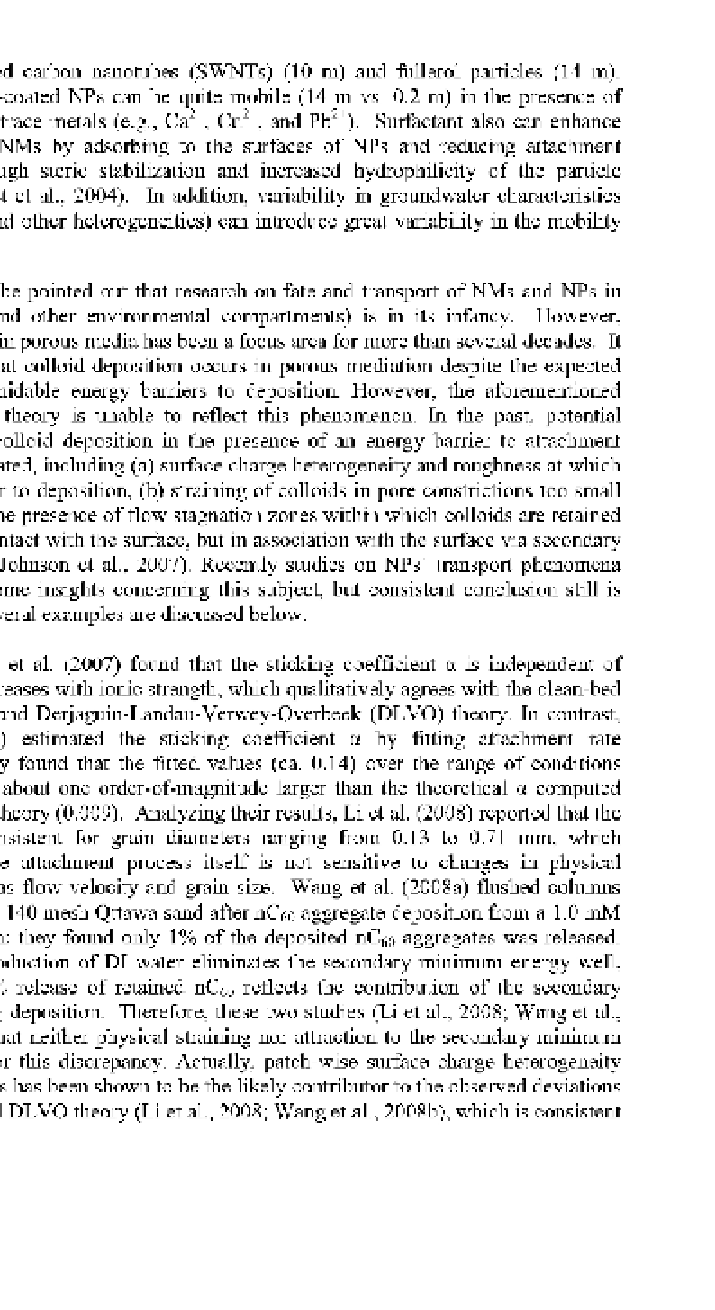Environmental Engineering Reference
In-Depth Information
than single-walled carbon nanotubes (SWNTs) (10 m) and fullerol particles (14 m).
However, humic-coated NPs can be quite mobile (14 m vs. 0.2 m) in the presence of
strongly sorbing trace metals (e.g., Ca
2+
, Cu
2+
, and Pb
2+
). Surfactant also can enhance
the mobility of NMs by adsorbing to the surfaces of NPs and reducing attachment
efficiencies through steric stabilization and increased hydrophilicity of the particle
surface (Lecoanet et al., 2004). In addition, variability in groundwater characteristics
(e.g., fractures and other heterogeneities) can introduce great variability in the mobility
It should be pointed out that research on fate and transport of NMs and NPs in
porous media (and other environmental compartments) is in its infancy. However,
colloid retention in porous media has been a focus area for more than several decades. It
is well known that colloid deposition occurs in porous mediation despite the expected
presence of formidable energy barriers to deposition. However, the aforementioned
classic filtration theory is unable to reflect this phenomenon. In the past, potential
mechanisms of colloid deposition in the presence of an energy barrier to attachment
have been elucidated, including (a) surface charge heterogeneity and roughness at which
the energy barrier to deposition, (b) straining of colloids in pore constrictions too small
to pass, and (c) the presence of flow stagnation zones within which colloids are retained
without direct contact with the surface, but in association with the surface via secondary
energy minima (Johnson et al., 2007). Recently studies on NPs' transport phenomena
have provided some insights concerning this subject, but consistent conclusion still is
not available. Several examples are discussed below.
Espinasse et al. (2007) found that the sticking coefficient a is independent of
flow rate and increases with ionic strength, which qualitatively agrees with the clean-bed
filtration theory and Derjaguin-Landau-Verwey-Overbeek (DLVO) theory. In contrast,
Li et al. (2008) estimated the sticking coefficient a by fitting attachment rate
coefficients. They found that the fitted values (ca. 0.14) over the range of conditions
considered were about one order-of-magnitude larger than the theoretical a computed
from the DLVO theory (0.009). Analyzing their results, Li et al. (2008) reported that the
a values are consistent for grain diameters ranging from 0.13 to 0.71 mm, which
indicates that the attachment process itself is not sensitive to changes in physical
properties, such as flow velocity and grain size. Wang et al. (2008a) flushed columns
packed with 100-140 mesh Qttawa sand after nCeo aggregate deposition from a 1.0 mM
CaCi2 suspension; they found only 1% of the deposited nCeo aggregates was released.
Because the introduction of DI water eliminates the secondary minimum energy well,
this observed 1% release of retained nCeo reflects the contribution of the secondary
minimum to nCeo deposition. Therefore, these two studies (Li et al., 2008; Wang et al.,
2008a) suggest that neither physical straining nor attraction to the secondary minimum
be responsible for this discrepancy. Actually, patch-wise surface charge heterogeneity
on the sand grains has been shown to be the likely contributor to the observed deviations
from the classical DLVO theory (Li et al., 2008; Wang et al., 2008b), which is consistent

Search WWH ::

Custom Search